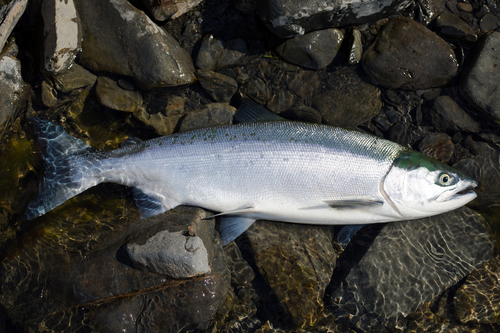
Introduction
Sockeye salmon, also known as red salmon, are a keystone species in the Pacific Northwest. Their unique life cycle, which includes both freshwater and ocean phases, supports a wide range of wildlife and contributes significantly to the health of aquatic ecosystems.
Life Cycle and Migration
Sockeye salmon are anadromous—born in freshwater lakes or rivers, they migrate to the ocean where they spend 1 to 4 years feeding and growing before returning to spawn in the same freshwater system where they hatched. During their ocean phase, sockeye are silver with a blue-green back, allowing them to blend into the marine environment. Once they return to freshwater to spawn, their bodies turn bright red with green heads—a stunning visual transformation.
Ecological Importance
Ocean sockeye are vital to both marine and terrestrial ecosystems:
-
Nutrient transport: When sockeye return to freshwater to spawn and die, their bodies decompose and release marine-derived nutrients into the soil and water. This enriches riverbanks and forests, supporting plants, insects, birds, and mammals.
-
Food source: Sockeye serve as prey for a variety of marine animals, including orcas, seals, and sea lions. On land, bears, eagles, and wolves feed heavily on spawning salmon.
-
Biodiversity: The presence of sockeye enhances overall biodiversity by supporting interconnected food webs.
Habitat and Range
Ocean sockeye salmon are native to the North Pacific Ocean and its adjoining river systems in North America (from California to Alaska) and Asia (particularly around Japan and Russia). Major spawning rivers include the Fraser River in British Columbia and the Kvichak River in Alaska.
Threats and Conservation
Sockeye populations face several challenges:
-
Climate change: Rising ocean temperatures and altered river flows impact migration and spawning success.
-
Overfishing: Commercial and recreational fishing pressure can reduce wild populations.
-
Habitat degradation: Dams, logging, mining, and urban development disrupt spawning habitats and juvenile rearing environments.
-
Aquaculture impacts: Farmed salmon can spread disease and parasites to wild sockeye populations.
Efforts to protect sockeye include habitat restoration, fishing regulations, dam removals, and international cooperation on fisheries management.
Conclusion
Ocean sockeye salmon are more than just a fish—they are a vital link between ocean and land, sustaining ecosystems and human communities alike. Protecting them ensures the health of rivers, forests, oceans, and future generations.

You must be logged in to post a comment.